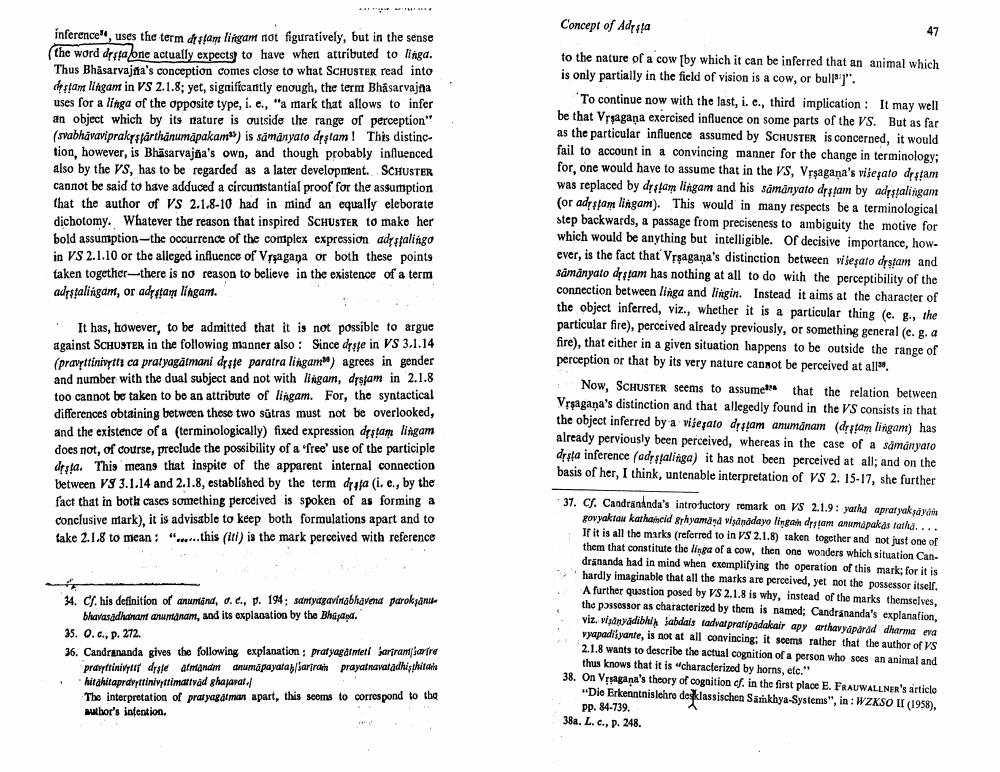Book Title: Note On Concept Adrsta As Used In Vaisesika Sutra Author(s): A Wezler Publisher: A Wezler View full book textPage 7
________________ Concept of Adysta inference", uses the term distam lingam not figuratively, but in the sense (the word desione actually expects to have when attributed to linga. Thus Bhāsarvajra's conception comes close to what SCHUSTER read into de stam lingam in VS 2.1.8; yet, significantly enough, the term Bhasarvajna uses for a linga of the opposite type, i.e., "a mark that allows to infer an object which by its nature is outside the range of perception" (svabhāvaviprakrsparthanumāpakam") is samanyato destam! This distinc. tion, however, is Bhäsarvajña's own, and though probably influenced also by the VS, has to be regarded as a later development. SCHUSTER cannot be said to have adduced a circumstantial proof for the assumption that the author of Vs 2.1.8-10 had in mind an equally eleborate dichotomy. Whatever the reason that inspired SCHUSTER to make her bold assumption--the occurrence of the complex expression adesalingo in VS 2.1.10 or the alleged influence of Vragana or both these points taken together there is no reason to believe in the existence of a term adpstalinigam, or adestam lingam. to the nature of a cow by which it can be inferred that an animal which is only partially in the field of vision is a cow, or bulloj". "To continue now with the last, i. e., third implication : It may well be that Vrsagana exercised influence on some parts of the VS. But as far as the particular influence assumed by SCHUSTER is concerned, it would fail to account in a convincing manner for the change in terminology: for, one would have to assume that in the VS, Vrsagana's visesato drsam was replaced by distam lingam and his sámányato destam by adrsalingam (or adestam lingam). This would in many respects be a terminological step backwards, a passage from preciseness to ambiguity the motive for which would be anything but intelligible. Of decisive importance, however, is the fact that Vrsagana's distinction between viseşato dystam and samanyato dystam has nothing at all to do with the perceptibility of the connection between linga and lingin. Instead it aims at the character of the object inferred, viz., whether it is a particular thing (e. g., the particular fire), perceived already previously, or something general (e. g. a fire), that either in a given situation happens to be outside the range of perception or that by its very nature cannot be perceived at all. : Now, SCHUSTER seems to assume that the relation between Vrsagana's distinction and that allegedly found in the VS consists in that the object inferred by a vijesato distam anumanam (drsamlingamt) has already perviously been perceived, whereas in the case of a sámányato desta inference (adrsalinga) it has not been perceived at all; and on the basis of her, I think, untenable interpretation of VS 2. 15-17, she further It has, however, to be admitted that it is not possible to argue against SCHUSTER in the following manner also : Since dyste in VS 3.1.14 (pravyttinivytti ca pratyagātmani dyste paratra lingam ) agrees in gender and number with the dual subject and not with lingam, drstam in 2.1.8 too cannot be taken to be an attribute of lingam. For, the syntactical differences obtaining between these two sutras must not be overlooked, and the existence of a (terminologically) fixed expression dystan lingam does not, of course, preclude the possibility of a 'free' use of the participle desta. This means that inspite of the apparent internal connection between VS 3.1.14 and 2.1.8, established by the term drifa (i. e., by the fact that in both cases something perceived is spoken of as forming a conclusive nark), it is advisable to keep both formulations apart and to take 2.1.8 to mean : "......this (iti) is the mark perceived with reference 34. Cf. his definition of anumand, d. c., p. 194: santyagavinabhavend paroksanu. bhavasadhanant anuntanant, and its explanation by the Bhaja. 35. O.c., p. 272. 36. Candrananda gives the following explanation : pratyagarmeti jarfram/Sarfra pravyftinivyer drste amandmanumāpayatab/Sarfrae prayatnawatadhishitati hitahitaprayfinivittimattvad ghajarat/ The interpretation of prafyasatman apart, this seems to correspond to the author's intention. - 37. Cf. Candrananda's introductory remark on VS 2.1.9: yatha aprafyak paycinie govyakta karhancid grhyamad visanadayo lingach dystam anumapakas tatha. If it is all the marks (referred to in VS 2.1.8) taken together and not just one of them that constitute the linga of a cow, then one wonders which situation Candrananda had in mind when exemplifying the operation of this mark; for it is hardly imaginable that all the marks are perceived, yet not the possessor itself. A further question posed by VS 2.1.8 is why, instead of the marks themselves. the possessor as characterized by them is named; Candrananda's explanation. viz. vipanyadibhijabdals tadvat pratipädakair apy arthavyaparad dharma era yyapadi yante, is not at all convincing: it seems rather that the author of VS 2.1.8 wants to describe the actual cognition of a person who sees an animal and thus knows that it is characterized by horns, etc." 38. On Vrsagana's theory of cognition ef. in the first place E. FRAUWALLNER's article "Die Erkenntnislehre des klassischen Samirkhya-Systems", in: WZKSO LI (1958), Pp. 84-739. 38a. L. c., p. 248.Page Navigation
1 ... 5 6 7 8 9 10 11 12 13
